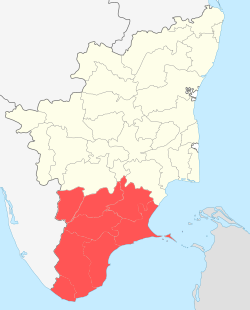Pandya Nadu | |
|---|---|
Geographical region | |
| Pandya/Pandi Nadu | |
 Pandya Nadu region within Tamil Nadu | |
| Country | |
| State | Tamil Nadu |
| Covering districts | Madurai, Theni, Ramanathapuram, Sivaganga, Virudhunagar, Tenkasi, Tirunelveli, Thoothukudi, Kanyakumari, Parts of Pudukkottai, Parts of Dindigul |
| Largest City | |
| Area |
|
| Government | |
| • Body | Government of Tamil Nadu, Government of India |
| Population | |
| • Total | 15,616,770 |
| Languages | |
| • Major | Tamil, English |
| • Others | Telugu, Kannada, Malayalam, Saurashtra |
| Time zone | Indian Standard Time |
Pandya Nadu or Pandi Nadu is a geographical region comprising the southern part of the present day state of Tamil Nadu. The region is bounded on its West by the Venad/Ay Nadu, Northeast by the Chola Nadu and Northwest by the Kongu Nadu. It comprises the present-day districts of Madurai, Theni, Sivaganga, Ramanathapuram, Virudhunagar, Tirunelveli, Tenkasi, Thoothukudi, Kanniyakumari, parts of Pudukkottai and Dindigul.[1][2]
The region was the principal historic seat of the Pandya dynasty who ruled it intermittently and with differing capacities at least from the 4th century BCE to 1759 CE.[3] The political capital of the region is the city of Madurai with Korkai serving as a secondary capital and the principal port city during the early historic period.[4]
After the end of the Sangam age in the third century BCE, the region came under of the occupation of the Kalabhras who continued to possess it till the Pandyan reconquest led by Kadungon who founded the First Pandyan Empire. The Medieval Cholas conquered the region from the Pandyas in the 10th century and renamed it the Rajaraja Pandimandalam. The region became independent once again with the rise of the Second Pandyan Empire which continued to be the dominant power in Tamil Nadu until the invasions of the Delhi Sultanates. The result of which was the formation of the independent Madurai Sultanate with the Pandya rulers pushed southwards from the Vaigai belt. The Madurai Sultanate was then overthrown by the Vijayanagara Prince, Kumara Kampana, and the region was reinstated to the later Pandyas as vassals and as one of the rajyams under the Vijayanagara Empire. After the decline of the Vijayanagara Empire in the 16th century, the Nayaks of Madurai declared independence and ruled the region until the conquest of the Nawab of Carnatic which was then followed shortly by the British annexation in the 18th century into the Madras Presidency.[4]
- ^ "Pandiya Nadu". Retrieved 26 December 2017.
- ^ Stein, Burton (1977). "Circulation and the Historical Geography of Tamil Country". The Journal of Asian Studies. 37.
- ^ N., Sethuraman (1993). The Later Pandyas (1371 - 1759 AD). Tiruchirapalli: The Epigraphical Society of India.
- ^ a b Sastri, K. N. (1972). The Pandyan Kingdom.
© MMXXIII Rich X Search. We shall prevail. All rights reserved. Rich X Search
